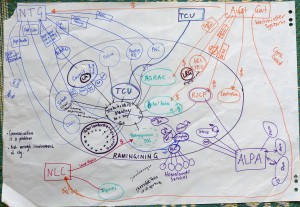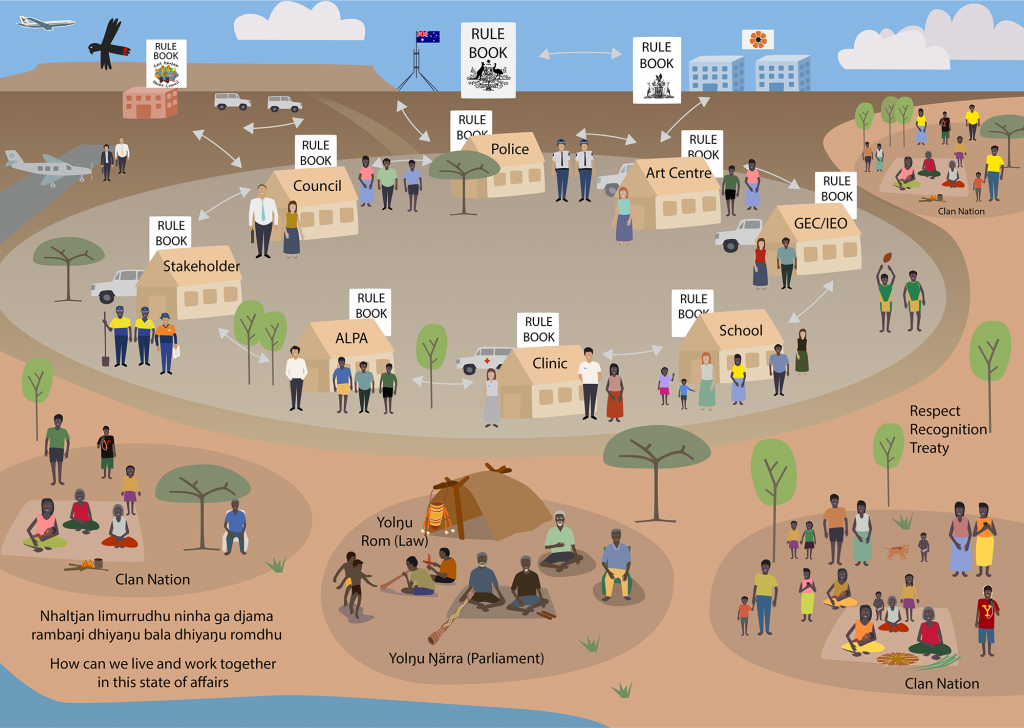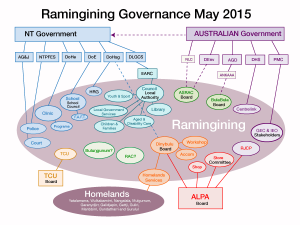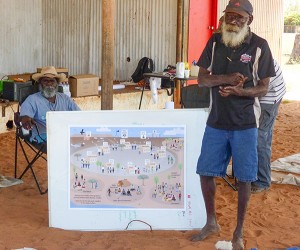Don’t leave us out
 In one visit two facilitators (T and J) and Yolŋu consultant (M) were talking about governance in Ramingining and all the different ‘balanda’ stakeholder groups or ‘bodies’ in Ramingining and their affiliations with government and nongovernment organisations. J began drawing a picture on butchers paper as we talked. Looking at the drawing, M talked about ‘communication’ being a real problem. Not enough involvement of Yolŋu community members in the running of the community through different agencies, Balanda not communicating properly with Yolŋu and vice versa. With issues like school attendance, health and safety etc. most community members don’t understand how agencies have responsibility and how this connects with the community. They don’t know enough about the Australian, NT and local government laws, policies and programs how these are implemented. M pointed out that, ‘There is a current and Yolŋu are caught in the government current which is pulling Yolŋu to their way of learning and doing things. Yolŋu have things. I need to think what I have and what I can do. Yolŋu have land, sea, bush, culture. What I have I can use to make something useful in the modern world’. Later J re-drew it in Word and shared it. This new picture provoked different conversations. ‘Where are Yolŋu leaders in this picture? How do Yolŋu leaders fit into this stakeholder governance picture? No Yolŋu body in the picture. M remembered the days of the ‘Village Council’ in the 1960’s. ‘Maybe we should look at the Village Council again?’ We talked about the VC as a Yolŋu stakeholder group under Yolŋu governance and leadership and operate according to Yolŋu rom (law/protocols/processes). ‘All we would expect is the outside world’s respect’.
In one visit two facilitators (T and J) and Yolŋu consultant (M) were talking about governance in Ramingining and all the different ‘balanda’ stakeholder groups or ‘bodies’ in Ramingining and their affiliations with government and nongovernment organisations. J began drawing a picture on butchers paper as we talked. Looking at the drawing, M talked about ‘communication’ being a real problem. Not enough involvement of Yolŋu community members in the running of the community through different agencies, Balanda not communicating properly with Yolŋu and vice versa. With issues like school attendance, health and safety etc. most community members don’t understand how agencies have responsibility and how this connects with the community. They don’t know enough about the Australian, NT and local government laws, policies and programs how these are implemented. M pointed out that, ‘There is a current and Yolŋu are caught in the government current which is pulling Yolŋu to their way of learning and doing things. Yolŋu have things. I need to think what I have and what I can do. Yolŋu have land, sea, bush, culture. What I have I can use to make something useful in the modern world’. Later J re-drew it in Word and shared it. This new picture provoked different conversations. ‘Where are Yolŋu leaders in this picture? How do Yolŋu leaders fit into this stakeholder governance picture? No Yolŋu body in the picture. M remembered the days of the ‘Village Council’ in the 1960’s. ‘Maybe we should look at the Village Council again?’ We talked about the VC as a Yolŋu stakeholder group under Yolŋu governance and leadership and operate according to Yolŋu rom (law/protocols/processes). ‘All we would expect is the outside world’s respect’.
Posters-for-talking…
In the next IGLDP visit several weeks later, M and other leaders were talking about the Milingimbi petition (website URL) and doing something similar at Ramingining. They were also talking about drafting an MOU for all Ramingining stakeholders including Yolŋu of how to work together. M and T made a rough drawing together while thinking through the MOU idea. T showed M another poster he’d made of a generic community governance scenario and had trialled at Milingimbi a few weeks before. They used the elements from this poster with the MOU drawing to make a ‘poster-for-talking’ showing the current state of affairs with ‘Balanda’ stakeholders, governed by their Rule Books or Constitutions and their connections to the Australian and NT governments. After showing drafts to other elders we started looking at some concepts of Yolŋugovernance and how different it is from the Balanda system and made some edits to show the Yolŋu clan nations each governed by their Sacred Dilly Bag and how these are not recognised by the dominating Balanda stakeholder governance landscape. A draft of the poster was sent to the IGLDP Steering Committee who noted Local Government was missing.
The final poster has been used in all three IGLDP towns and with Yolŋu Nations Assembly to stimulate conversations about governance. Yolŋu consultants and other leaders have copies of the printed poster http://igld.cdu.edu.au/ramingining/
Drawing together as we are talking prompts conversation, helps us to explain our ideas and reveals important cultural and other differences in the way we understand things. It supports us to work collaboratively, to generate collective understanding and most importantly, to do our ‘difference’ respectfully and well. The pictures are also traces of our journey together through a landscape of shared understanding we have performed and created together. When we do this work particularly well, the pictures often start to resonate and do their own work. The pictures themselves provoke, stimulate and generate dialogue. They become ‘actors’ in the dialogue. These pictures we develop slowly and carefully through using them with other people over time, watching how they work until we feel we have a version that is ready for printing.

The poster came from some earlier work we did in mapping out the governance bodies and networks in Ramingining.

The final poster was used on many occasions to talk around ideas of governance and leadership, below Dhulumburrk makes a point at the recent Yolŋu Nations Assembly meeting.
